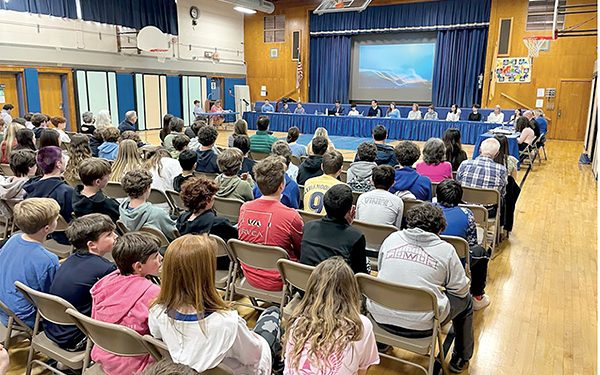
By Sunayana Prabhu
FAIR HAVEN – “I was riding my bike on Third Street and realized there are a lot of potholes. Are we going to fix them?”
“There’s a lot of animal crossings across McCarter Pond. Are you going to enforce speed limits on Fair Haven Road?”
“Is there any way we could improve the intersection of Ridge Road and Fair Haven? There are a lot of accidents due to blind spots.”
The voices were young but the questions were sharp, as Knollwood School revived its annual tradition of pairing student council members with their borough council counterparts for a regular council meeting, all to inspire civic engagement.
Mayor Josh Halpern, who normally opens council meetings at 7 p.m. in borough hall, presided over a 1:30 p.m. meeting Monday in the school’s assembly hall, seated next to eighth grader Araceli English, president of Knollwood Student Council.
During the meeting the borough’s governing body – including Halpern, borough administrator Theresa Casagrande, borough clerk Allyson Cinquegrana, council president Elizabeth Koch, and council members Christopher Rodriguez, Laline Neff, Tracy Cole, Kristen Hoey and Andrew LaBarbera – introduced students to their roles running the business of the borough and the challenges they face in bringing projects to fruition.
Cole gave an overview of the executive branch of the borough, made up of six legislators. She shared with the students that their responsibilities as elected officials include “adopting the budget, enacting new laws, amending laws, and generally advocating for the voice of people.”
“I’m very excited to be your mayor,” Halpern told the hall packed with students from grades six through eight. “My job is to put together the agenda, to find the spirit of the town and share it with everyone that’s involved. And most importantly, I really try my best to get the governing body on the same page to move things that are important to this town.”
Adding more perspective to their roles, Rodriguez said the reason he ran for office was to get involved and provide service to the community. He encouraged students to “continue being active in student government and also in your community.”
While council members prided themselves on the sense of community, volunteerism among residents, and camaraderie within the council that all work together to keep the borough flourishing, governing is not without its challenges.
Providing insights into the constraints the council faces for the smooth running of the borough, council members said both funding and time were two of the biggest challenges to completing projects.
Halpern said one of the challenges is to “hold back” on ideas to minimize spending. “We have to work underneath the structure of different (financial) caps that we have,” he said, “our responsibility to our taxpayers at the end of the day is to deliver the best for them with every decision that we make.”
Although the setting for the council meeting changed for the day, borough business continued as usual. Among the agenda items were discussions on the ongoing design plans for the borough’s police department and community center.
LaBarbera gave a PowerPoint presentation on updates to the plans. The borough’s technical design and review committee has recommended a special planning board meeting for April 3 where LaBarbera will also be presenting the plans. If no significant changes are cited, then the project will move to the construction document phase. The buildings will be all electric; council is awaiting more information on whether the community center could be built partly of timber and partly of steel.
The council also decided to move the micro-projects update to the next meeting, scheduled for April 17. Micro projects are infrastructure improvements fully funded by the borough; they include drainage and curb and sidewalk improvements in multiple locations throughout the borough.
Araceli, the student council president, and vice president Finn Buckley, also an eighth grader, said they gained valuable experience by shadowing the council members.
During the meeting, Araceli also spoke about student body accomplishments in the 2022-23 school year, which included organizing events such as the Halloween dance, the Super Bowl food drive, daily announcements during Black History Month to introduce important Black figures in history, and much more.
The annual tradition of the “Marchese” meeting, named for former borough council member Robert Marchese who introduced the idea, was a staple for years before being paused for COVID. The purpose of the annual meeting is to build leadership skills and help students understand the roles and responsibilities of a governing body “based on the fact that (the students) have their own board as president, vice president, secretary and treasurer, very similar to mayor and how the responsibilities are dispersed amongst the team” on the borough council, said Amy Romano, principal of Knollwood School.
It was interesting that the council members had “well-thought-out responses to every single scenario,” English said, noting the experience can be applied to their own student council meetings. “It showed our positions in greater perspective,” she said.
The article originally appeared in the March 30 – April 5, 2023 print edition of The Two River Times.














